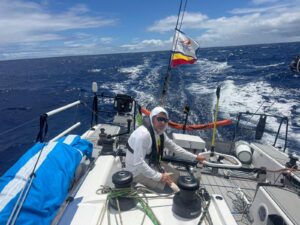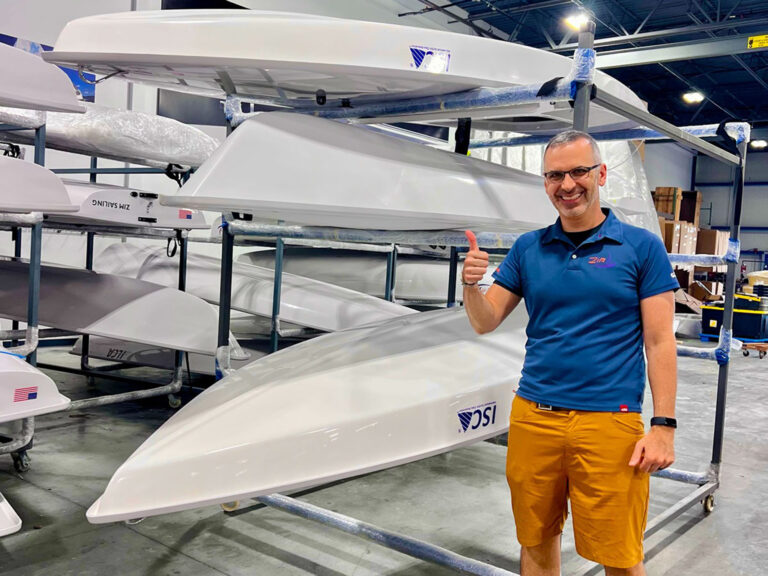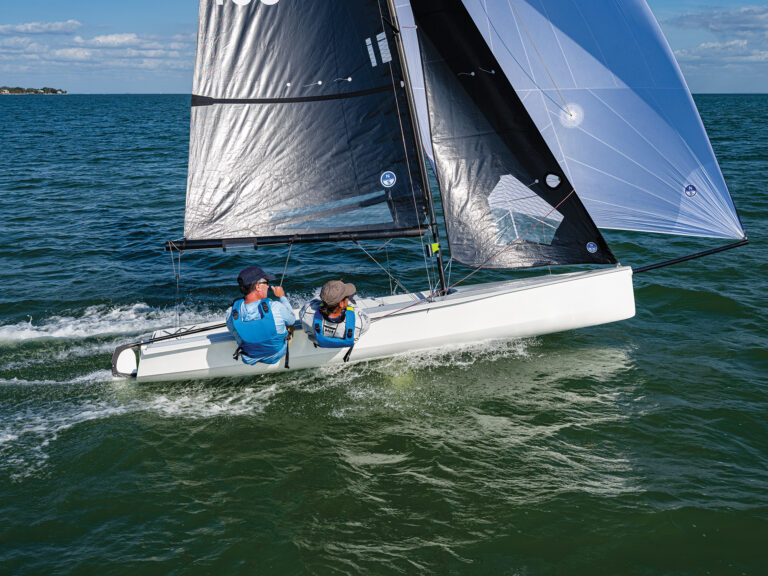
Allan Terhune Jr., of Annapolis, Maryland, finally found himself among the illustrious short-listers of the 2023 Rolex Yachtsman of the Year award. As a sailmaker 15 years and counting, Terhune has won plenty of regattas as both skipper and crew, but 2023 was especially good, putting up big wins in the MC Scow Class, securing his first 6-Metre World Championship title as tactician, and then wrapping up the year with a gold medal in the Lightning Class at the Pan American Games in Chile. One could say he’s getting faster with age, but he’d say, he’s simply having more fun.
Why was 2023 such an especially productive year?
A bunch of things came together, but I think what made a difference was that I started doing a few more projects that I wanted to do. The MC Scow changed my perspective on the sport. The class is growing, especially in New Jersey, where I grew up, and a bunch of my friends bought MCs. There is something refreshing about throwing the boat on the car by myself, meeting my buddies somewhere, and just going sailing. There’s no client to manage, and I don’t need to find a crew. It’s just me alone in the boat again, so it kind of reinvigorated everything.
What about it changed your perspective?
The MC Scow really brought me back to the basics, and rekindled everything that made me fall in love with sailing in the first place. It reminded me to have fun. Obviously, I do it for work and it’s a job, but no matter how much any of us love our line of work, sometimes we need that reminder of why we fell in love. It’s about sailing with my friends from junior sailing or college and having fun. Every time I get a little grouchy, [my wife] Cate tells me that I need to pull the MC out of the garage and go sailing.
The 6-Metre sailing was just super fun, and it was a great opportunity to sail such a cool and classic boat with an amazing history. To do it with friends that I’d won the J/24 Worlds with [in 2022] added to the fun factor. It was all new and something I was fired up about. Same thing with the Lightning. The effort was more about what I wanted to do rather than what I had to do.
Is the MC Scow a totally new class for you?
I’d sailed MCs at the Championship of Champions 15 years or so ago, and that was fun. When I got my first boat, I was at a regatta in Florida, and I was sailing around and having fun, but then I started thinking, I’m kind of hungry. And then I was like, Oh, man, now I’m the one who has to bring the food. And the radio. And everything else. It was a good reminder about being self-sufficient and doing it myself. That’s been really good for me in a lot of ways.
What have been the steps to getting up to speed in new-to-you classes?
Doing basic stuff, which means just tacking and jibing well. I did a lot of stuff where I would video myself with a GoPro, just to see where hiccups were—like the hand-to-tiller transfer. I went to a regatta with a couple of guys, and we had sort of a coach—not a professional coach, but just someone to point out differences to us. The MC is a funny little boat because it has to be heeled, which is contrary to everything else we do. And that was kind of the hardest part, but once I figured that out, it was all good.
With the 6-Metre [owned by Newport, Rhode Island’s Jamie Hilton], most of us were new to it, and we had three weeks to figure it out. We committed to keeping it basic, and it was amazing. As soon as we started deviating to rig tuning or finer parts of the boat, we ended up taking a step backward. As soon as we went right back to tacking better and getting the sails up and down better, everything improved. It was also good to be more open-minded to learning things and talking to people and seeing what they can tell us and seeing if it works. I think that was the good part, a reminder that sailing isn’t as black-and-white as we all think or people say.
Give us an example.
With the 6-Metre, it was something as simple as how we sat on the boat. Everyone was telling us that we have to sit below the deck to get the waterline down, and we were like, that makes no sense. On every other boat we sail, we sit on the rail. So, we said we’re going to sit on the rail, and everyone’s still telling us we’re wrong. But, hey, we’re winning a lot of races and going pretty fast, and halfway through the regatta, we see other boats with people sitting on the side. It wasn’t that we are smarter or anything; it was that we weren’t shackled to the norms.
You tried before to earn a berth for the Pan American Games and came up short, but this time you got your berth with your crew, Sarah Chin and Madeline Baldridge. Why are the Pan Am games so important to you?
It’s just a really amazing experience. I’ve sailed in the Lightning class for more than 20 years, and I’ve always known that I would never be on an Olympic path, so for me, this was the closest I would get. The games are a very big deal, especially for other sports, and when you’re there, it’s pretty close to a real Olympic experience. Seeing how the US team works from the inside, and being part of that team, was fun and inspiring.
We have a great group of athletes and leaders, and seeing it from the inside was special. It’s an experience that I don’t think you can really replicate because you’re there not just for yourself. You’re also there for your own country. It’s just so different and has a completely different vibe to it.
In all that you do as a pro sailor and sailmaker, how do you keep the enjoyment aspect in focus?
I think it’s just about being more relaxed about it all and realizing that if I don’t win the next race, it’s not the end of the world—move on to the next. Someone once told me: “You can sail well and not win, or you can sail really crappy and win. Which way is better?” And that’s so true. It’s about wrapping your head around the fact that sometimes we sail really well, but there’s still someone who beat us. It’s OK. It’s about finding ways to play the game better, or to your abilities, or whatever it is, and being happy with that. It’s more about the process than the result, and I kind of hate that saying, but it’s actually true.
Sounds like you’re getting older and wiser; is that changing how you race?
Oh, yeah. Honestly, 15 years ago, I think everything was forced, where it was always like a panic or a need to force good things to happen. Maybe I’m more relaxed, I don’t know, but I have much more of a patient outlook, kind of letting things develop and trying to think it through. Also, remembering that the rules are there to keep boats apart, not as a tactical weapon to win races. I think about all the situations a little bit differently and how you actually get better at it when you realize that the purpose of the rules is to keep us apart. So, maybe it’s just old age, or being wiser about it and not being so hyped up and forcing things like I did before.
With all that wisdom now, how do you approach starts?
I don’t like how everyone says that the safest thing to do is start in the middle or go for the low-density start—it’s not that easy when everybody’s trying to do the same thing. The biggest thing that I took away recently was getting onto starboard tack for the final approach, and understanding how to speed up and slow down—maintaining that ability to instantaneously speed up when you need to. A coach once explained it to me like this: In your car, it’s a lot easier to go from 30 to 60 than it is from zero to 60. It’s the same thing on a boat. You can approach the line with a controlled pace, and when you need to go, it’s a lot easier than if you are head-to-wind and luffing. I think it’s actually harder to start now than it was 20 years ago because people are much more refined and the electronics have made it even tougher because everyone knows where the line is.
How about the first beat: What are Terhune’s top tips?
The first part of the race is really about getting off the line and getting away as clean and as fast as you can. In the early and middle half of the beat, you should be sailing the windshifts and really owning the side that you picked.
The last quarter of the leg should be all about traffic management. One of the things we talked about on the Lightning when we were doing the North Americans is shifting from pressure-and-windshift mode to traffic mode. In the last minute of a beat, a little windshift is not going to make a huge difference, but your positioning will.
And how about downwind rules of thumb?
I think downwind, you have to be by yourself. When boats are together, they inherently go slower, so you have to find your own space. The other one is being really comfortable with your modes. The worst thing you can do is be stuck somewhere between a high mode and a low mode. If you want to soak low, just do it. If you want to go high and go faster, don’t hesitate. It’s about knowing when to and how to, and a lot of that is just time spent sailing your boat. There’s this belief that your practice time has to be with other boats and having a coach and doing drills, but you can learn a lot by sailing your boat alone and just going for a ride to know how it feels. Grab your friends, fill the cooler, and go sailing.
Best practices for a crowded leeward gate?
My default is to round the left gate because, when or if you have to tack, you are tacking onto starboard and you have right-of-way, whereas, if you round the right gate and something goes wrong, you have to tack and cross people on port, which makes it even more precarious.
Finish the race for us.
With upwind finishes, it’s much like starting, meaning there will be a favorite end. Never finish in the middle of the line because you’re giving distance one way or the other. If you pick the wrong end, so be it, but finishing in the middle is just crazy.
With downwind finishes, the easy trap to fall into is treating it like a gate. You don’t want to end up in that middle zone, where you are kind of between two packs and you never actually get through. So, on the downwind side, at some point, you just have to get to an end, and like basketball, stay between your man and the hoop.









